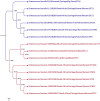Genome analysis of multidrug resistant Enterococcus faecium and Enterococcus faecalis circulating among hospitalized patients in uMgungundlovu District, KwaZulu-Natal, South Africa
- PMID: 38965470
- PMCID: PMC11225414
- DOI: 10.1186/s12879-024-09380-3
Genome analysis of multidrug resistant Enterococcus faecium and Enterococcus faecalis circulating among hospitalized patients in uMgungundlovu District, KwaZulu-Natal, South Africa
Abstract
Background: Vancomycin-resistant enterococci (VRE) are important pathogens categorized as high-priority bacteria in the Global Priority List of Antibiotic-Resistant Bacteria to Guide Research, Discovery, and Development of New Antibiotics published by the World Health Organization. The aim of this study was to determine the risk factors, resistance, virulence, mobilomes associated with multidrug-resistant and clonal lineages of Enterococcus faecium and faecalis circulating among hospitalized patients following the health system in South Africa, using whole genome sequencing (WGS).
Methods: A cross-sectional study was conducted during a two-month periods among hospitalized patients in 2017. Rectal swabs were collected from patients admitted to medical and surgical wards in an urban tertiary hospital, and a rural district hospital in uMgungundlovu district, South Africa. Enterococci were screened for vancomycin resistance on bile esculin azide agar supplemented with 6 mg/L of vancomycin and confirmation of VRE was done using ROSCO kits. Conventional and real-time PCR methods were used to ascertain the presence of VanA, VanB, VanC-2/3 and VanC-1 genes. All six multidrug-resistant Enterococcus faecalis and faecium selected were identified using multiplexed paired-end libraries (2 × 300 bp) with the Nextera XT DNA sample preparation kit (Illumina, San Diego, CA, USA) and genome sequencing was done using Illumina MiSeq instrument with 100× coverage at the National Institute of Communicable Diseases Sequencing Core Facility, South Africa. Antibiotic resistance genes, virulence factors, plasmids, integrons and CRISPR were characterized using RAST, ResFinder, VirulenceFinder, PlasmidFinder, PHAST and ISFinder respectively.
Results: Sequencing analysis revealed that these strains harbouring numerous resistance genes to glycopeptides (vanC[100%], vex3[100%], vex2[83,33%] and vanG[16,66%]), macrolides, lincosamides, sterptogramine B (ermB[33,32%], Isa[16,66%], emeA[16,66%]) and tetracyclines (tetM[33,32%]) in both district and tertiary hospitals. Multidrug efflux pumps including MATE, MFS and pmrA conferring resistance to several classes of antibiotics were also identified. The main transposable elements observed were in the Tn3 family, specifically Tn1546. Four single sequence types (STs) were identified among E. faecium in the district hospital, namely ST822, ST636, ST97 along with a novel ST assigned ST1386, while one lineage, ST29 was detected in the tertiary hospital.
Conclusion: The study reveals the genetic diversity and high pathogenicity of multidrug-resistant Enterococcus faecalis and faecium circulating among hospitalized patients. It underlines the necessity to implement routine screening of admitted patients coupled with infection control procedures, antimicrobial stewardship and awareness should be strengthened to prevent and/or contain the carriage and spread of multidrug resistant E. faecium and E. faecalis in hospitals and communities in South Africa.
Keywords: Enterococcus; Carriage; Hospitals; Mobilome; WGS.
© 2024. The Author(s).
Conflict of interest statement
Professor Essack is a member of the Global Respiratory Infection Partnership and the Global Hygiene Council sponsored by unrestricted educational grants from Reckitt and Benckiser, UK. All other authors declare that there is no competing financial and non-financial interest.The authors have declared that no competing interests exist.
The authors have declared that no competing interests exist.
Figures


Similar articles
-
Sentinel Surveillance reveals phylogenetic diversity and detection of linear plasmids harboring vanA and optrA among enterococci collected in the United States.Antimicrob Agents Chemother. 2024 Nov 6;68(11):e0059124. doi: 10.1128/aac.00591-24. Epub 2024 Oct 15. Antimicrob Agents Chemother. 2024. PMID: 39404260 Free PMC article.
-
Analysis of molecular epidemiological characteristics and antimicrobial susceptibility of vancomycin-resistant and linezolid-resistant Enterococcus in China.BMC Med Genomics. 2024 Jul 1;17(1):174. doi: 10.1186/s12920-024-01948-x. BMC Med Genomics. 2024. PMID: 38951840 Free PMC article.
-
Vancomycin-resistant enterococci isolates colonizing and infecting haematology patients: clonality, and virulence and resistance profile.J Hosp Infect. 2018 Jul;99(3):346-355. doi: 10.1016/j.jhin.2017.10.010. Epub 2017 Oct 21. J Hosp Infect. 2018. PMID: 29066140
-
Thirty years of VRE in Germany - "expect the unexpected": The view from the National Reference Centre for Staphylococci and Enterococci.Drug Resist Updat. 2020 Dec;53:100732. doi: 10.1016/j.drup.2020.100732. Epub 2020 Oct 27. Drug Resist Updat. 2020. PMID: 33189998 Review.
-
Glycopeptide-resistant enterococci: a decade of experience.J Med Microbiol. 1998 Oct;47(10):849-62. doi: 10.1099/00222615-47-10-849. J Med Microbiol. 1998. PMID: 9788808 Review.
Cited by
-
High Prevalence of Multidrug-Resistant Bacterial Colonization Among Patients and Healthcare Workers in a Rural Ethiopian Hospital.Antibiotics (Basel). 2025 Jul 17;14(7):717. doi: 10.3390/antibiotics14070717. Antibiotics (Basel). 2025. PMID: 40724018 Free PMC article.
-
Geophagia among pregnant women: evaluating the microbiological and toxicological safety of calabash chalk and its implications on maternal health.Environ Geochem Health. 2025 Jul 30;47(9):347. doi: 10.1007/s10653-025-02656-w. Environ Geochem Health. 2025. PMID: 40736606 Free PMC article. Review.
References
MeSH terms
Substances
Grants and funding
LinkOut - more resources
Full Text Sources
Molecular Biology Databases

